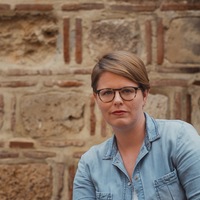
Nassar Mansour
Address: Jordan
less
Related Authors
Bilal Orfali
American University of Beirut
Armando Salvatore
McGill University
Sean W . Anthony
Ohio State University
Bruno De Nicola
Austrian Academy of Sciences
Gizem Tongo
Hacettepe University
Gregory Stournaras
National Technical University of Athens
Ersoy TOPUZKANAMIŞ
Balikesir University
Emily Neumeier
Temple University
Christiane Gruber
University of Michigan
Walid Saleh
University of Toronto
InterestsView All (7)










Uploads
Papers by Nassar Mansour
facilities giving them the comforting sense of luxury and wealth.
Nasta’liq script which developed from the old ta’liq script is one of the most mature styles of Arabic calligraphy since it could be written in different sizes successfully; starting from the very minute size used in miniature paintings to jali size applied on monuments. Nasta’liq has many distinguished artistic features that differentiate it from other cursive styles. One of these features and perhaps the most notable one is the inclination of its upright letters toward the right from top while the same letters in the other styles lean towards left. Nasta’liq is used widely in copying works of literature and official documents written mainly in Persian and Ottoman and sometimes in Arabic. Nasta’liq is written in different styles or madrasa; the most widely spread is Persian madrasa، then the Ottoman، followed by Indian/Pakistani and Shami.
لا نعرف الكثير عن حياة الصيرفي شأنه شأن أقرانه من خطاطي القرن الثامن الهجري وبالتحديد من عرفوا "بالأساتذة الستة", إلا أن آثاره الخطية القليلة والنادرة تدل على استاذيته العالية في فن الخط. تقدم هذه الدراسة تعريفا وافيا بحياة الصيرفي من خلال ما وفرته المصادر العربية وغير العربية من معلومات عن حياته, ومسيرته الفنية, وآثاره الخطية.
يسعى الباحث هنا إلى تقديم دراسة تحليلية لأسلوب الصيرفي في خط النسخ الذي كتبت به هذه المخطوطة القرآنية وتفوق الصيرفي في كتابته. موضحة بنماذج تفصيلية من هذا المخطوط النادر الذي ظهر مؤخرا في بعض المجموعات الخاصة, متبوعة بجدول يبين أشكال الحروف المفردة لخط النسخ واتصالاتها المتنوعة مستخلصة من هذا المخطوط.
Abdullah al-Sayrafi is one of the most distinguished calligraphers of the 8th and 9th H/14th and 15th AC centuries who followed the way of Yaqut al-Musta'simi (d. 698H/1298AC) and helped spreading it in the eastern part of the Islamic world. His way of writing was adopted by Sheikh Hamdullah al-Amasi (d. 926H/1520AC); the head calligrapher of the Ottoman school of calligraphy which is considered the most mature and popular at the present time.
We know not much about the life of al-Sayrafi same as for most of the 8th century calligraphers particularly those who were known as ‘the six masters’. Nevertheless, the few and rare manuscripts written by him are obvious evidences on his high mastership.
This paper presents a comprehensive study of the life and works of al-Sayrafi through what calligraphy references have offered of information with an attempt to list down what remains of his writings. It analyses his way in writing naskh script which he mastered the most through presenting detailed samples of his unique manuscript which have recently appeared in some private collections. It includes an index for the form of the individual letters in naskh script which were extracted from the manuscript.
البواب (ت ٤١٣ ه/ ١٠٢٢ م) وياقوت المستعصمي ( ٦٩٨ ه/ ١٢٩٨ م).
تجمع المصادر التاريخية على أستاذيته في فن الخط، فإن كتاباته الفنية وآثاره الخطية غير
معروفة ولا منشورة، بالرغم من أنه كتب الكثير وعلم عددا لا يحصى من التلاميذ.
يتناول هذا البحث بالدراسة والتحليل الجوانب الفنية لأسلوب ياقوت الموصلي في الخط
وبالأخص خط النسخ الذي كتب به هذا المخطوط النادر. كما يقدم هذا البحث إضاءة على
حياة هذا الفنان الكبير الذي يعود له الفضل في نشر أسلوب ابن البواب في الخط في مصر
والعراق والشام.
لقد أعددت في نهاية البحث جدولا يتضمن مفردات خط النسخ مستخلصة من هذا المخطوط،
تمثل أسلوب ياقوت الموصلي وابن البواب.
Yaqut al-Mouselli is one of the most outstanding figures in the series of Arabic calligraphy art. He stands remarkable between two eminent masters; Ibn al-Bawwab (d. 413H/1022AC) and Yaqut al-Musta'simi (d.698H/1298AD). He produced a huge number of manuscripts; nevertheless, what is known from his own writing is very limited. This paper discusses in details the artistic features of Yaqut's way in calligraphy, specifically Naskh script. Moreover, it sheds light on Yaqut's life and his great role in spreading Ibn al-Bawwab's way in calligraphy throughout
Egypt, Iraq and Syria from late 6th/12th century until the mid 10th century. This paper is followed by an appendix of Naskh script letters form extracted from the manuscript. It shows the way of Yaqut al-Mouselli and his master Ibn al-Bawwab in Arabic calligraphy.
facilities giving them the comforting sense of luxury and wealth.
Nasta’liq script which developed from the old ta’liq script is one of the most mature styles of Arabic calligraphy since it could be written in different sizes successfully; starting from the very minute size used in miniature paintings to jali size applied on monuments. Nasta’liq has many distinguished artistic features that differentiate it from other cursive styles. One of these features and perhaps the most notable one is the inclination of its upright letters toward the right from top while the same letters in the other styles lean towards left. Nasta’liq is used widely in copying works of literature and official documents written mainly in Persian and Ottoman and sometimes in Arabic. Nasta’liq is written in different styles or madrasa; the most widely spread is Persian madrasa، then the Ottoman، followed by Indian/Pakistani and Shami.
لا نعرف الكثير عن حياة الصيرفي شأنه شأن أقرانه من خطاطي القرن الثامن الهجري وبالتحديد من عرفوا "بالأساتذة الستة", إلا أن آثاره الخطية القليلة والنادرة تدل على استاذيته العالية في فن الخط. تقدم هذه الدراسة تعريفا وافيا بحياة الصيرفي من خلال ما وفرته المصادر العربية وغير العربية من معلومات عن حياته, ومسيرته الفنية, وآثاره الخطية.
يسعى الباحث هنا إلى تقديم دراسة تحليلية لأسلوب الصيرفي في خط النسخ الذي كتبت به هذه المخطوطة القرآنية وتفوق الصيرفي في كتابته. موضحة بنماذج تفصيلية من هذا المخطوط النادر الذي ظهر مؤخرا في بعض المجموعات الخاصة, متبوعة بجدول يبين أشكال الحروف المفردة لخط النسخ واتصالاتها المتنوعة مستخلصة من هذا المخطوط.
Abdullah al-Sayrafi is one of the most distinguished calligraphers of the 8th and 9th H/14th and 15th AC centuries who followed the way of Yaqut al-Musta'simi (d. 698H/1298AC) and helped spreading it in the eastern part of the Islamic world. His way of writing was adopted by Sheikh Hamdullah al-Amasi (d. 926H/1520AC); the head calligrapher of the Ottoman school of calligraphy which is considered the most mature and popular at the present time.
We know not much about the life of al-Sayrafi same as for most of the 8th century calligraphers particularly those who were known as ‘the six masters’. Nevertheless, the few and rare manuscripts written by him are obvious evidences on his high mastership.
This paper presents a comprehensive study of the life and works of al-Sayrafi through what calligraphy references have offered of information with an attempt to list down what remains of his writings. It analyses his way in writing naskh script which he mastered the most through presenting detailed samples of his unique manuscript which have recently appeared in some private collections. It includes an index for the form of the individual letters in naskh script which were extracted from the manuscript.
البواب (ت ٤١٣ ه/ ١٠٢٢ م) وياقوت المستعصمي ( ٦٩٨ ه/ ١٢٩٨ م).
تجمع المصادر التاريخية على أستاذيته في فن الخط، فإن كتاباته الفنية وآثاره الخطية غير
معروفة ولا منشورة، بالرغم من أنه كتب الكثير وعلم عددا لا يحصى من التلاميذ.
يتناول هذا البحث بالدراسة والتحليل الجوانب الفنية لأسلوب ياقوت الموصلي في الخط
وبالأخص خط النسخ الذي كتب به هذا المخطوط النادر. كما يقدم هذا البحث إضاءة على
حياة هذا الفنان الكبير الذي يعود له الفضل في نشر أسلوب ابن البواب في الخط في مصر
والعراق والشام.
لقد أعددت في نهاية البحث جدولا يتضمن مفردات خط النسخ مستخلصة من هذا المخطوط،
تمثل أسلوب ياقوت الموصلي وابن البواب.
Yaqut al-Mouselli is one of the most outstanding figures in the series of Arabic calligraphy art. He stands remarkable between two eminent masters; Ibn al-Bawwab (d. 413H/1022AC) and Yaqut al-Musta'simi (d.698H/1298AD). He produced a huge number of manuscripts; nevertheless, what is known from his own writing is very limited. This paper discusses in details the artistic features of Yaqut's way in calligraphy, specifically Naskh script. Moreover, it sheds light on Yaqut's life and his great role in spreading Ibn al-Bawwab's way in calligraphy throughout
Egypt, Iraq and Syria from late 6th/12th century until the mid 10th century. This paper is followed by an appendix of Naskh script letters form extracted from the manuscript. It shows the way of Yaqut al-Mouselli and his master Ibn al-Bawwab in Arabic calligraphy.